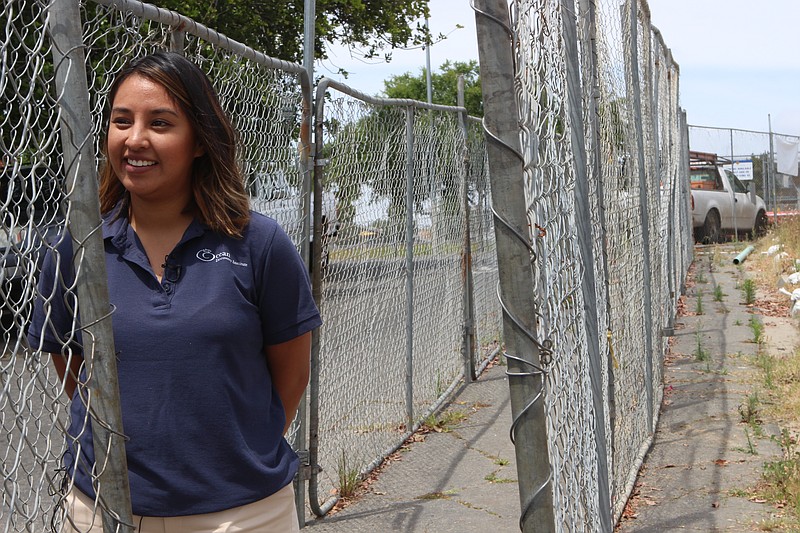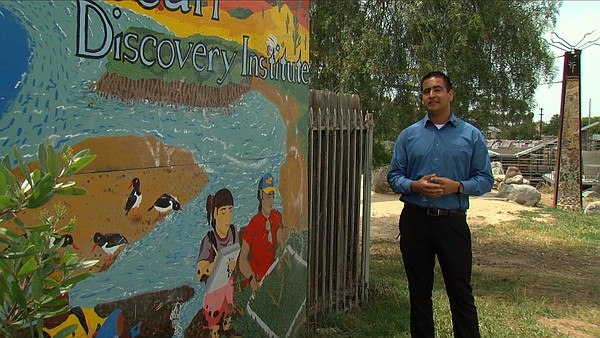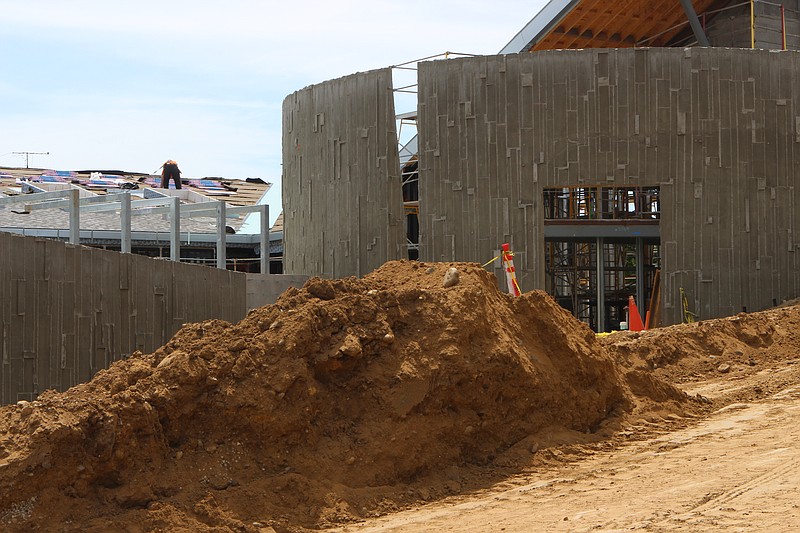By the beginning of next school year, students in one of San Diego’s underserved communities could be conducting research alongside a scientist from the National Oceanic and Atmospheric Administration. That is the vision behind the Living Lab, a $15 million tuition-free learning and research center coming to the City Heights neighborhood.
The project, slated to open in September, comes from the Ocean Discovery Institute, a nonprofit that teaches kids about science and conservation through the nearby canyons that feed into the Pacific. Through a partnership with the San Diego Unified School District, the state-of-the-art facility will allow the institute to expand its successful programming and establish the nonprofit as a permanent fixture in the low-income neighborhood.
The new campus will include two laboratories, a garden, a community kitchen and a studio apartment for a scientist-in-residence, the organization’s Carla Pisbe Camacho said on a recent tour of the construction site.
“We really wanted it to feel like an active field station,” said Pisbe Camacho, the institute’s manager of business development. The organization is hoping a researcher from NOAA, one of its partners, will be the first to fill the live-in role.
 Ocean Discovery Institute Manager of Business Development Carla Pisbe Camacho stands near the chain link fence surrounding the organization’s future Living Lab, April 24, 2017. |
The nonprofit already provides programming to more than half of the community’s children. But with the Living Lab, Camacho said it will be able reach all 10,000 students that attend and feed into the neighborhood’s Hoover High School, a low-performing institution.
“It’s about providing opportunities for students that wouldn’t even imagine that these are career opportunities,” Pisbe Camacho said.
Ocean Discovery Institute’s slogan is “young lives transformed through science” and it’s goal is to bolster science education for the urban community. It delivers this through a three-tier model: community education activities, classroom instruction and a long-term learning track for its most engaged participants.
One of the program’s long-term alums is Antonio Figueroa. He’s now a sales manager at a camera company that’s developing a monitoring system for small fishing vessels, but he said a career in science wasn’t what he pictured.
 Antonio Figueroa speaks about his experience with Ocean Discovery Institute, April 24, 2017. |
“My family doesn’t have any science background,” Figueroa said. “I’m the first to go to college and graduate.”
As a kid, Figueroa said he already had big dreams for his future — he wanted to be an architect — but he credits Ocean Discovery Institute with his success.
“They opened a door for me to learn and expand my possibilities,” he said. “Going to UCLA, I mean they helped me with college applications, college trips…I did not have the fantastic 4.0 GPA at UCLA, but they were there, always supporting.”
According to Ocean Discovery Institute’s own data analysis, many of its in-depth participants boast similar accomplishments. Academically, the dozens of students in its third-tier curriculum significantly outperformed their Hoover peers. The nonprofit reports 92 percent of its 75 alumni are currently enrolled in college or have completed their bachelor’s degree. In comparison, 45 percent of Hoover graduates from the 2014-15 school year — the the most recent data available — met the University of California and/or California State University entrance requirements.
The Ocean Discovery Institute’s model is considered so successful, its founder Shara Fisler was recognized by the Obama Administration, nominated for a CNN Heroes Award and named a KPBS Local Hero. Now, the nonprofit is working with NOAA to replicate its program on the other side of the country in the Chesapeake Bay area.
San Diego Unified Superintendent Cindy Marten said the mission of the upcoming Living Lab aligns with the district’s priorities outlined in its three-year plan.
“If you look at our Local Control and Accountability Plan, two main goals is to close the achievement gap and offer a broad and challenging curriculum — this does that,” said Marten, a former City Heights teacher and principal.
The district helped fund construction of the Living Lab through taxpayer approved bonds but the facility and curriculum will be managed by Ocean Discovery Institute. School Board President Richard Barrera said the shared-cost agreement is a first for the district and presents a unique opportunity for City Heights.
“Again, in other communities you might have parents paying thousands of dollars to get kids access to the kind of quality programming that goes on here at (Ocean Discovery Institute), so to be able to offer that for free through the public education system is a tremendous opportunity,” he said.
There are still a few more months before the Living Lab will open its doors but Camacho said the institute is already excited about the opportunities its new facility will offer.
“This building sets the highest expectations for our students,” she said. “For them to know that I’m from City Heights but I will become a scientist I will become a leader in science and conservation…or that will go on and discover a life-saving drug in a biotech company or things like that. So I think it’s really changing how students think about themselves and how other people think about these student as well.”
Camacho, the daughter of Filipino and Mexican immigrants who met in City Heights, was also a former student at the Ocean Discovery Institute.
 A mound of earth sits in front of the under-construction rotunda that will serve as the entrance to Ocean Discovery Institute’s upcoming Living Lab in San Diego’s City Heights neighborhood, April 24, 2017.
A mound of earth sits in front of the under-construction rotunda that will serve as the entrance to Ocean Discovery Institute’s upcoming Living Lab in San Diego’s City Heights neighborhood, April 24, 2017.
